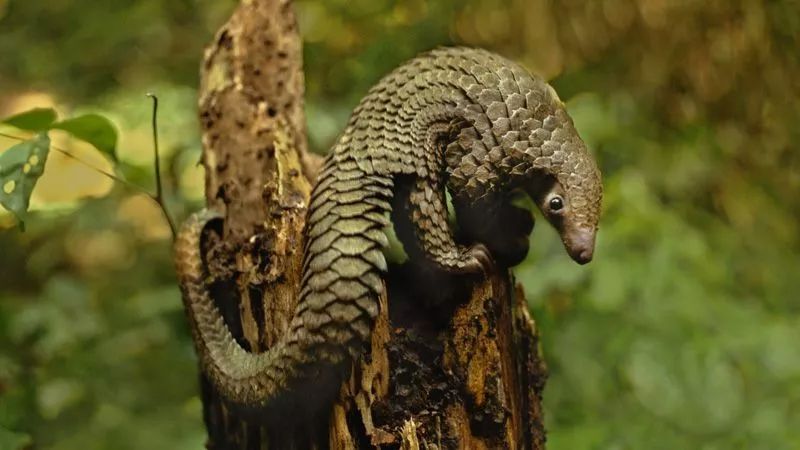Did pangolins spread the China coronavirus to people?
NATURE NEWS
Genetic sequences of viruses isolated from the scaly animals are 99% similar to that of the circulating virus — but the work is yet to be formally published.
David Cyranoski
 Pangolins are scaly creatures often used in traditional Chinese medicine.Credit: Frans Lanting/National Geographic
Pangolins are scaly creatures often used in traditional Chinese medicine.Credit: Frans Lanting/National Geographic
Researchers in Guangzhou, China, have suggested that pangolins — long-snouted, ant-eating mammals often used in traditional Chinese medicine — are the probable animal source of the coronavirus outbreak that has infected more than 30,000 people and is wreaking havoc worldwide.
China virus: latest news on spreading infection
The identity of the animal source of the coronavirus, named nCoV-2019, has been one of the key questions that researchers have been racing to answer. Coronaviruses are known to circulate in mammals and birds, and scientists have already suggested that nCoV-2019 originally came from bats, a proposal based on the similarity of its genetic sequence to those of other known coronaviruses. But the virus was probably transmitted to humans by another animal. The coronavirus that caused severe acute respiratory syndrome, or SARS, spread from bats to civet cats to humans.
Now, the South China Agricultural University in Guangzhou says that two of its researchers, Shen Yongyi and Xiao Lihua, have identified the pangolin as the potential source of nCoV-2019 on the basis of a genetic comparison of coronaviruses taken from the animals and from humans infected in the outbreak and other findings. The sequences are 99% similar, the researchers reported at press conference on 7 February.
A good candidate
Previously, researchers have noted that coronaviruses are a possible cause of death in pangolins1, and that nCoV-2019 and coronaviruses from pangolins use receptors with similar molecular structures to infect cells.
What you need to know about the novel coronavirus
Even before today’s announcement, pangolins were a good candidate for being an intermediate species for the virus, so it’s very interesting that the researchers have found such a close sequence, says David Robertson, a computational virologist at the University of Glasgow, UK.
Pangolins are protected animals, but illegal trafficking is widespread, and some species are critically endangered. They are sold, controversially, for their meat and scales, and for use in traditional Chinese medicine, in which parts of the animal are used to treat ailments such as skin diseases, menstrual disorders and arthritis. Chinese law states that people selling pangolins can be punished by 10 years or more in prison.
The coronavirus emerged in the Chinese city of Wuhan in December, and is thought to have leapt to humans at a seafood and wild-animal market, where many of the first people to become infected worked. Pangolins were not listed on an inventory of items sold at the market — although the illegality of trading pangolins could explain this omission.
Last month, scientists in Beijing claimed that snakes were the source of nCoV-2019, but that theory was dismissed by other researchers.
Shen and Xiao did not immediately respond to Nature’s requests for comment, but Liu Yahong, president of the South China Agricultural University, told the press conference that the results would be published soon to help efforts to control the coronavirus.
Scientists hope that the paper will offer details including where the team found the pangolins with the similar virus. Arinjay Banerjee, a coronavirus researcher at McMaster University in Hamilton, Canada, says that another crucial detail is where in pangolins the researchers found the virus — for example, whether it was isolated from blood samples or rectal swabs. This will help to determine how it might have been passed to humans and how such transmission could be prevented in the future.
“I can definitely believe it could be true,” says Kristian Andersen, an immunologist and computational biologist at Scripps Research in La Jolla, California. Andersen says he has compared publicly available sequences of pangolin viruses and found that they are similar to that of nCoV-2019. “I look forward to the published report and data.”
doi: 10.1038/d41586-020-00364-2
References Liu, P., Chen, W. & Chen, J.-P. Viruses 11, 979 (2019).
译文:
是穿山甲把新型冠状病毒传染给了人吗?
研究人员从穿山甲体内分离出的病毒的基因序列,与新型冠状病毒的序列相似度高达99%。目前,研究结果尚未正式发表。
穿山甲是一种吻部较长、以蚂蚁为食的哺乳动物,常被用作中药材。日前,广州的研究人员提出,穿山甲有可能是此次新型冠状病毒的动物来源。截至2月7日,新型冠状病毒已致3万多人感染,疫情影响全球。

穿山甲是一种全身有鳞甲的动物,常被用作中药材。来源:Frans Lanting/National Geographic
研究人员通过基因分析得出上述结论——科学家认为这似乎是可信的,但也提醒称,这项研究工作尚未以完整形式发表。“这是一个很有意思的观察。虽然我们还需要看到更多的细节,但研究结论确实说得通,因为其他数据也显示,穿山甲携带的一些病毒与新型冠状病毒的亲缘关系很近。”澳大利亚悉尼大学的演化病毒学家Edward Holmes说。
新型冠状病毒又被称为“nCoV-2019”,研究人员一直想要尽快确定它的动物来源,这一点非常关键。已知冠状病毒会在哺乳动物和鸟类中传播,科学家已经提出,新型冠状病毒最初来源于蝙蝠——主要基于新型冠状病毒的基因序列与其它已知冠状病毒的较为相似。不过,新型冠状病毒很有可能是通过另一种动物传播给人类的。导致SARS的冠状病毒就是先从蝙蝠传到果子狸身上,再由果子狸传给人。
华南农业大学的沈永义和肖立华对比了穿山甲和新型冠状病毒感染者体内的基因样本,并结合其他研究结果,发现穿山甲可能是新型冠状病毒的潜在来源。两位研究人员在2月7日举行的新闻发布会上表示,二者序列之间的相似度高达99%。
中间宿主
曾有研究人员指出,冠状病毒是导致穿山甲死亡的一个可能原因1,而穿山甲体内冠状病毒感染细胞所用的受体的分子结构,与新型冠状病毒的十分相似。
英国格拉斯哥大学的计算病毒学家David Robertson说,在7日的新闻发布会之前,穿山甲就一直被认为是新型冠状病毒的一个潜在中间宿主,因此,研究人员发现了如此相近的序列确实很有意思。
穿山甲属于保护动物,但非法贩运的现象非常普遍,部分种类的穿山甲已属于极危动物。虽然有争议,但穿山甲的肉和鳞片交易一直存在,某些身体部位还被用来制作中药,治疗皮肤病、月经不调和关节炎等疾病。中国的法律规定,贩卖穿山甲可被判刑10年或以上。
去年12月,新型冠状病毒在武汉市出现,被认为是在一个海鲜和野生动物市场传染给了人,第一批感染患者中有许多都是这个海鲜市场的工人。穿山甲并不在该海鲜市场的销售清单上——可能是因为穿山甲交易是非法的。
上个月,北京的几位研究人员称蛇是新型冠状病毒的来源,但这种观点被其它研究人员否定。
沈永义和肖立华并未立即回复《自然》的评论请求,但华南农业大学校长刘雅红在新闻发布会上表示,研究很快就会发表,以帮助控制病毒的蔓延。
科学家希望即将发表的论文能详细阐述,研究团队在哪里找到了具有相似病毒的穿山甲。加拿大麦克马斯特大学的冠状病毒研究人员Arinjay Banerjee表示,还有一点非常关键,即研究人员在穿山甲的哪个部位发现了病毒,比如说,病毒是从血液样本还是从直肠拭子中分离得到的。这些问题有助于确定病毒是通过哪种途径跑到人类身上的,以及如何预防将来的病毒传播。
“我很相信可能就是穿山甲。”美国斯克里普斯研究所的免疫学家和计算生物学家Kristian Andersen说。他对现已公开的穿山甲病毒序列进行了比对,发现它们与新型冠状病毒序列很像。“我非常期待看到即将发表的论文和数据。”